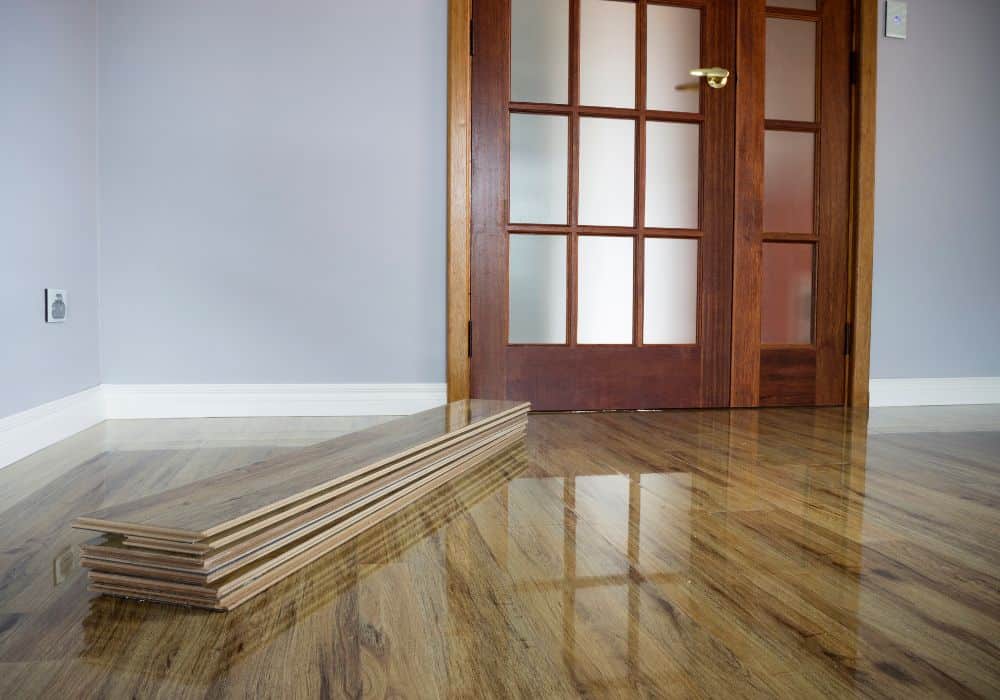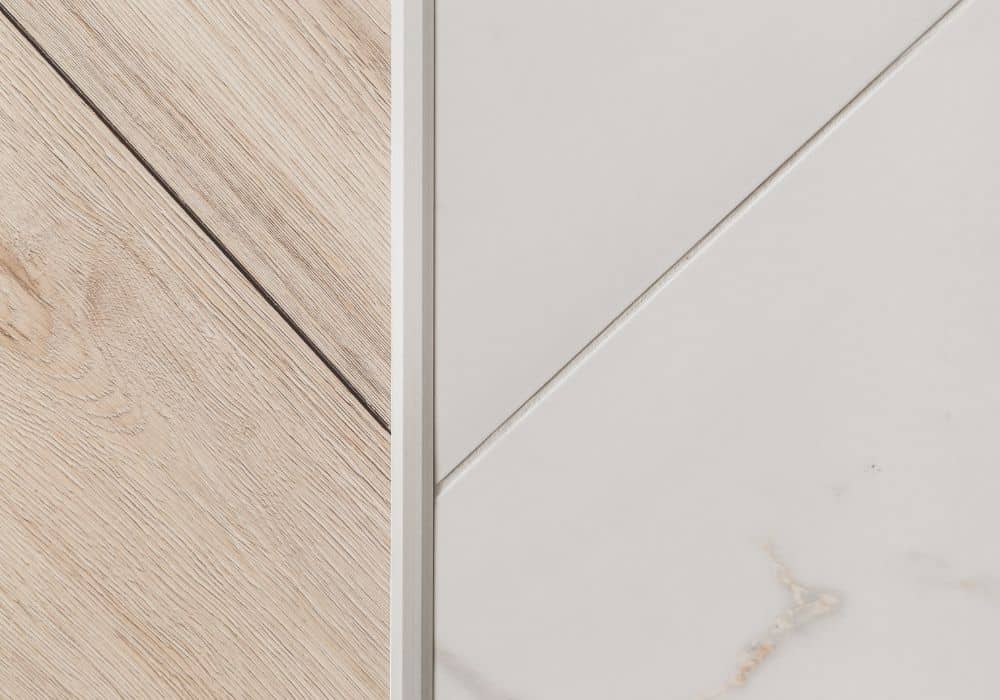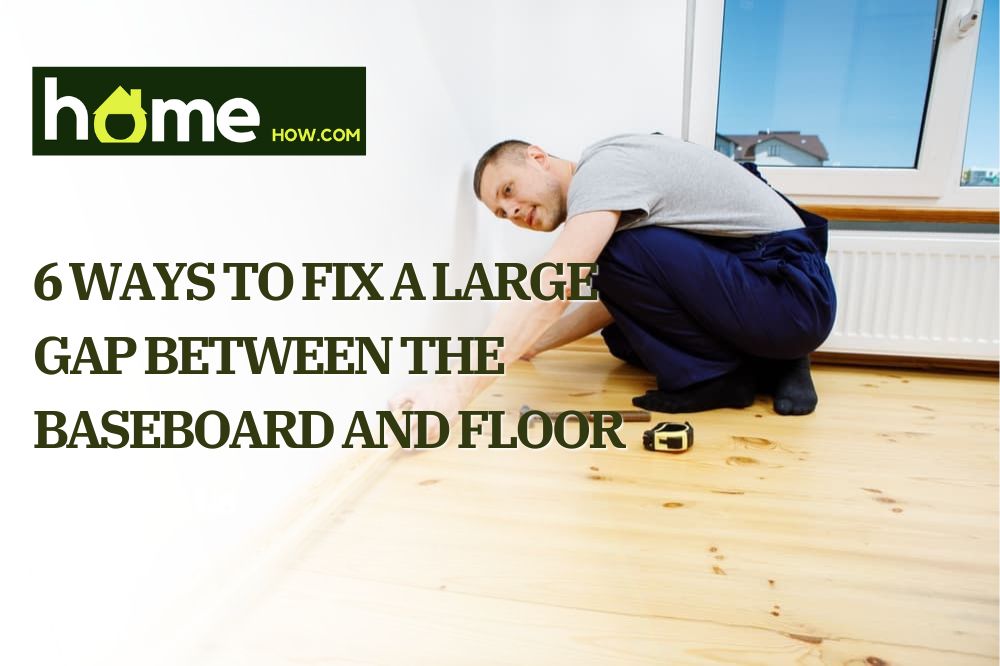Seeing the gap between the baseboard and the floor will surely drive you crazy if you’re a person who likes cleanliness and tidiness. And even if you’re not, having it in your house is just unnecessary.
So, this situation has surely led you to ask yourself how to fix a large gap between the baseboard and the floor. Is there anything that could solve this problem? The house was built a long time ago; the floor was installed a long time ago; there’s no going back.
The answer is yes. The answer is actually yes times six because we’ll be giving you six solutions to this problem. Whether it’s old age, bad installation or construction, or maybe water damage that has caused the gap to appear, we’ll help you.
How To Fix A Large Gap Between The Baseboard And Floor?
1. Floor Board

This method will not work with a tile floor, but it’s probably the easiest fix if you use laminate, parquet, or vinyl flooring.
The reason for this is as follows. If you’ve ever read home improvement articles about installing any type of flooring, you’ve probably come across the advice that you should buy more flooring material than you will actually need since you never know what problems will occur during installation or after extensive usage.
That’s not the case here, but if you followed that advice, you now have some extra flooring material in your garage.
To apply this method, you need to shorten the length and width of the sheet of floorboard so that it will fit into the hole between the baseboard and the floor. After that, place that piece in the gap, and your problem will be solved.
If you want to ensure that the floorboard is perfectly connected to the existing flooring, you can use adhesive.
However, before we say goodbye to this method, we should also mention that this isn’t the most aesthetically pleasing solution, as it might appear as if there are two layers of flooring, one on top of the other.
2. Quarter Round
We’re now moving onto prettier fixes but also fixes that will require a little more work and money. Not much more, though.
A quarter round is a type of molding shaped like a quarter of a circle. The shape is the reason behind its name, just in case you don’t know it already.
You can use quarter-round molding in the following way. You need to cut it to a length that corresponds to that of the gap. After that, you need to fasten it to the baseboard, which you can do in two ways.
The first is to use nails. Do not worry that hammering nails will make your interior look ugly, as you will undoubtedly spackle the nail heads and paint the molding to match the existing baseboard. One thing you need to do before you start painting is to use wood filler to repair the damage done by nail holes.
If you don’t like the idea of hammering nails, there is something more elegant, which is the use of adhesive for fixing. However, before you decide to buy floor adhesive, you should keep in mind that removing the molding without damaging the baseboard or flooring will be challenging in the case of floor repair.
One last thing we should add here is that you can use a smaller molding size called eight-round if the gap is tiny.
3. Shoe Molding
The following fix on the list is shoe molding or base shoe, as it’s also called. This type of molding is similar to the previous one, but they differ in two areas.
The first is the height since the shoe molding is always taller than a quarter round. The second is the shape because the shoe molding is more elliptical or rectangular, while the quarter round is always circular.
The good thing about shoe molding is that there are a large number of designs, shapes, and colors that will match the existing baseboard and interior.
The shoe mold’s installation procedure is the same as in the previous fix.
4. Trim Strips

Another method to seal the floor and baseboard gap is trim strips. They are a quick and elegant solution that requires no experience or skill to install.
You can find them in all sizes, which means you’ll be able to hide any unsightly exposed hole in your house easily. Additionally, they come in a variety of colors so that you don’t have to worry about painting them to match the wall paint, for example.
Trim strips are made from silicone and use adhesive backing to stick to the surface, so you won’t have to deal with hammering and spackling nails. All you need to do is buy as much of this material as you need and tape it to the wall.
5. Caulk
If the gap between the baseboard and floor isn’t too large, i.e., at most a quarter of an inch, you can use caulk to seal it. This method is excellent because it will be almost impossible to notice that there was any work done, and that might not be the case with the fixes we previously discussed.
Firstly, you should choose the right caulk as not all are suitable for this job.
If you’re planning to do work in the bathroom or a similar humid area, use silicone caulk since it’s waterproof.
Latex caulk or acrylic latex caulk which is its other name, is better suited for other rooms in the house because it is paintable, can be utilized with both tile and wooden floors, and is quite flexible. It’s also as close to general-purpose caulk as possible.
Before applying caulk to the gap, apply blue painter’s tape to protect the flooring and baseboard from the excess caulk.
Now that you’ve secured the flooring, it’s time to fill the gap with caulk. Use a caulk gun to do this more precisely, as you don’t want the caulk spreading around your house.
Once you’ve finished, you can take a putty knife or calking tool to smooth the caulk and make it look as even as possible. After the caulk completely dries, apply the trim paint of your choosing.
Finally, remove the tape you used to protect the baseboard and flooring.
6. Change The Baseboard
The last fix is perhaps the most difficult and costliest because it requires the most labor and resources. Still, many people do not want to bother with the previous solutions, mainly because of the aesthetic effect an additional molding layer can have on the interior.
After all, you’re adding another layer to the existing one, which is the baseboard, and that’s not what many people find visually appealing.
Since this fix requires the most experience, it might be better to hire a contractor for this job, but in case you like DIY adventures, we will describe in 10 steps how to replace the baseboard.
We won’t be writing in much detail as this is a topic on which a separate article can be written. Still, we don’t want to hang you out to dry. So. here are the ten steps:
- Use a razor knife to cut the caulking along the top of the baseboard
- Apply a putty knife along the top of the baseboard by slowly pulling away from the wall to pry the baseboard
- When there’s enough space between the wall and the baseboard, use a prying tool or the reverse side of a hammer to remove the nails from the wall
- After all, the nails have been prayed out, remove the old baseboard
- Measure and cut the new baseboard elements with a miter saw so they can precisely fit in the places of the old ones
- Be careful how you cut baseboards parts that will be used on the edges and joints since there you will have two parts that need to fit in smoothly
- Nail the parts to the wall with a normal or a pneumatic nail hammer
- Apply the caulking to the top of the baseboards
- Smooth the caulking with a wet finger or caulking tool
- Paint the baseboard (you can also do this step before you start nailing the parts to the wall)
Conclusion
We would not wish for anyone to find themselves in this situation, but it’s simply impossible to have control over everything. The good thing is you came across this article and now know how to fix a significant gap between the baseboard and the floor.
The first method is to place a floorboard into the gap. Then, you can make use of a quarter-round or shoe molding, which fits in nicely with the baseboard.
If you’re looking for something less noticeable, there are options such as trim strips and caulk. Finally, if the gap is massive or you don’t like the previous fixes, you can choose to replace the baseboard completely.
If case you still have questions in your head in regard to this topic, we will be waiting for you in the comments.
